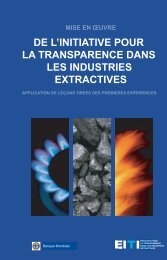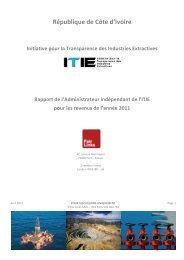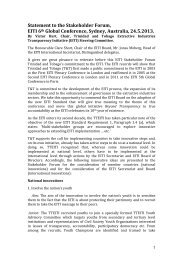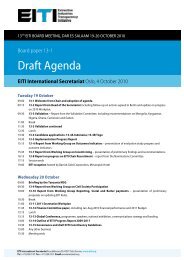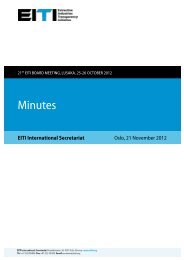Second National Reconcilation Study EITI Peru - unofficial…
Second National Reconcilation Study EITI Peru - unofficial…
Second National Reconcilation Study EITI Peru - unofficial…
You also want an ePaper? Increase the reach of your titles
YUMPU automatically turns print PDFs into web optimized ePapers that Google loves.
Consultoría para la Elaboración del Segundo Estudio Nacional de<br />
Conciliación de la Iniciativa de Transparencia para las Industrias<br />
Extractivas (ITIE) en el Perú (2008 – 2010) (continuación)<br />
uses this information to calculate the Mining Canon, which corresponds to 50% of the Income Tax<br />
paid by mining companies during the exploitation phase.<br />
2.2.1. Area of Influence<br />
To analyze the distribution of Mining Canon resources, we have defined the area of influence as<br />
territory of the Local and Regional Governments where mining concessions are currently engaging<br />
in exploitation.<br />
- When title holders possess mining concessions that are in the exploitation stage and located<br />
in different circumscriptions (different departments, provinces or districts), distribution is<br />
proportional to the tonnage of the extracted mineral based on the information provided by<br />
the General Directorate for Mining at the Ministry of Energy and Mines.<br />
- If mining concessions in the exploitation phase covers neighboring circumscriptions<br />
(meaning the mining unit’s extension involves more than one district, province or<br />
department), resources are distributed in equal parts.<br />
To distribute revenues from the Canon between district and provincial municipalities, we currently<br />
use the Digital Census Cartography developed by the <strong>National</strong> Institute of Statistics and Informatics<br />
(herewith INEI). This product is being used to demarcate the territorial circumscriptions of the<br />
country’s districts and provinces until an official cartographic map is developed to precisely mark<br />
the boundaries between all of <strong>Peru</strong>’s districts and provinces.<br />
2.2.2. Distribution Criteria<br />
The DGDFAS_MEF receives information on the administrative economic units operated by each<br />
mining company by District, Province and Department to identify the areas where the resources<br />
that generate the mining canon, which each company must pay to MEM through the General Office<br />
Of Mining, DGDFAS-MEF (formerly DGAES – MEF), are located.<br />
The mining canon is distributed in the following way among the regional and local governments<br />
according to stipulations in Article N° 5 of Ley N° 27506 – Canon Law (applicable for the 2008-2010<br />
period subject to analysis):<br />
(a) Ten percent (10%) of the total canon is assigned to the local governments of the<br />
municipality or district municipalities where the natural resource is extracted.<br />
(b) Twenty-five percent (25%) of the total canon is allotted to local governments in the province<br />
or provinces of the municipalities where the natural resource is exploited.<br />
(c) Forty percent (40%) of the total canon goes to local governments in the department or<br />
departments where the natural resources are exploited.<br />
(d) Twenty-five percent (25%) of the total canon is allotted to the regional governments where<br />
the natural resource is exploited.<br />
Table of Distribution Criteria:<br />
¡Error! Marcador no definido.<br />
Consultoría para la Comisión Multisectorial Permanente de la ITIE Perú<br />
42




